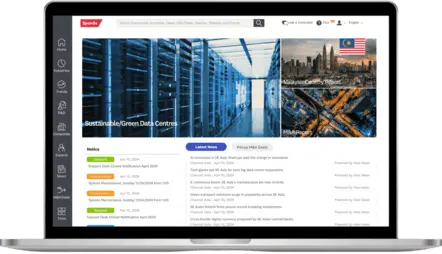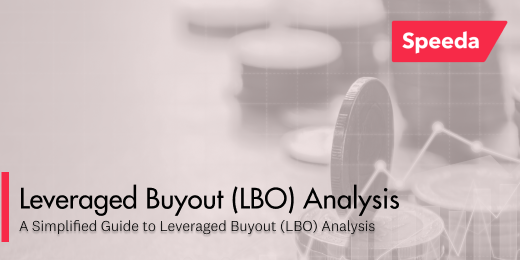Về Chúng Tôi
Speeda là một nền tảng trí tuệ doanh nghiệp cung cấp thông tin thiết yếu tập trung vào thị trường châu Á. Chúng tôi cung cấp dữ liệu chi tiết về các công ty tư nhân và thông tin chuyên sâu quan trọng về thị trường Đông Nam Á, bao gồm dữ liệu toàn diện về các công ty và thông tin ngành được biên soạn bởi các chuyên gia tư vấn địa phương dày dặn kinh nghiệm, đáp ứng nhu cầu nghiên cứu ban đầu của bạn.
Giải pháp được thiết kế dành riêng cho các chuyên gia, giúp tối ưu hóa hoạt động nghiên cứu, phân tích hồ sơ công ty, so sánh với đối thủ cạnh tranh, tìm kiếm cơ hội đầu tư và phân tích ngành, từ đó nâng cao hiệu quả ra quyết định kinh doanh. Nền tảng tích hợp tất cả trong một cung cấp thông tin chuyên sâu hữu ích về định giá doanh nghiệp và Báo cáo ngành, giúp bạn tiết kiệm thời gian và chi phí cho việc phân tích dữ liệu, từ đó đưa ra quyết định hiệu quả hơn.
Lựa chọn tin cậy của các tập đoàn uy tín








































 ?>
?> Lợi ích mà Speeda mang lại cho doanh nghiệp của bạn
Tương tác với cơ sở dữ liệu ở mỗi giai đoạn trong nghiên cứu
Giải pháp nâng cao chất lượng nghiên cứu của bạn từ giai đoạn xác định đề tài đến khi hoàn thành, giúp đơn giản hóa mọi giai đoạn trong quá trình nghiên cứu. Trải nghiệm hiệu quả vượt trội nhờ nguồn dữ liệu khổng lồ, khả năng phân tích chuyên sâu và các tùy chọn đầu ra linh hoạt của chúng tôi, tất cả đều được thiết kế để đáp ứng nhu cầu nghiên cứu cụ thể của bạn.
Xác định
Sử dụng thanh tìm kiếm để tìm kiếm thông tin về doanh nghiệp, ngành nghề, hoạt động mua bán và sáp nhập cũng như các dữ liệu khác.


Tìm kiếm
Truy cập hồ sơ doanh nghiệp, kết quả tài chính, báo cáo ngành và dữ liệu thị trường thông qua giao diện đơn giản.
Phân tích
Tùy chỉnh dữ liệu theo tiêu chí tìm kiếm, hiển thị dữ liệu và thiết kế biểu đồ cho phân tích của bạn


Tạo
Chọn và tải xuống dữ liệu doanh nghiệp và báo cáo ngành dưới định dạng PPT, DOC XLSX hoặc PDF chỉ với một cú nhấp chuột.

Thông tin thiết yếu về doanh nghiệp tập trung vào thị trường Châu Á
Truy cập không giới hạn vào cơ sở dữ liệu doanh nghiệp của chúng tôi với hơn 11 triệu công ty niêm yết và tư nhân trên toàn thế giới, bao gồm cả thông tin tài chính của họ. Speeda cung cấp dữ liệu toàn diện nhất về các công ty tư nhân trên khắp khu vực ASEAN-6, Nhật Bản, Trung Quốc và Hàn Quốc. Nền tảng này được các chuyên gia sử dụng để thu thập dữ liệu hàng ngày phục vụ nghiên cứu định giá doanh nghiệp, sàng lọc mục tiêu, tìm kiếm cơ hội đầu tư, đánh giá theo chuẩn đối sánh, phân tích ngành và nhiều hoạt động khác.
11.3M
Dữ liệu của các công ty tư nhân và đại chúng

Japan
627k

Singapore
632k

Malaysia
728k

Thailand
600k

Tiếng Việt
1.1M

Korea
71k

China
2.2M
Tiết kiệm thời gian và chi phí cho việc thu thập dữ liệu cho các dự án nghiên cứu của bạn
Nâng cao hiệu quả công việc với khả năng nắm bắt thông tin chuyên sâu về thị trường địa phương nhanh chóng chỉ trong vài phút. Speeda lưu trữ hơn 3.000 báo cáo, bao gồm cả báo cáo ngành để cung cấp cái nhìn toàn diện về xu hướng thị trường và làm nổi bật các doanh nghiệp tại Đông Nam Á. Những báo cáo này mang lại thông tin chuyên sâu hữu ích cho các chuyên gia tư vấn, phân tích thị trường và lập kế hoạch chiến lược doanh nghiệp, giúp họ nâng cao hiệu quả và độ chính xác của nghiên cứu thị trường, từ đó tạo ra những tác động tích cực cho doanh nghiệp.
Thông tin chuyên sâu về thị trường từ các chuyên gia địa phương
Đọc những bài viết chuyên sâu được cung cấp độc quyền trên Speeda. Được viết bởi các chuyên gia tư vấn nội bộ, các báo cáo tập trung vào những chủ đề nóng hổi đang diễn ra tại các quốc gia Đông Nam Á phát triển nhất. Hiểu rõ tác động của các xu hướng toàn cầu đến khu vực Đông Nam Á và các cơ hội phát triển mà các xu hướng này mang lại.
-
Global Synthetic Resin Industry Faces Growth Opportunities Amid Sustainability Shifts and Profit Margin PressuresThe global synthetic resin industry was valued at around USD 394 billion in 2021, with thermoplastic resins leading in revenue. Asia Pacific accounted for approximately 41% of the market, driven by demand from the packaging and automotive industries. Synthetic resins, created through polymerisation, are used in a wide range of industries such as plastics, paints, and varnishes. Polyethylene (PE) holds the largest market share, primarily due to its extensive use in packaging.After a strong rebound in 2021, global synthetic resin exports slowed in 2022. China, the world’s largest importer, saw its imports decline by 9% that year. Future growth for the industry is expected at a compound annual growth rate (CAGR) of 5% from 2021 to 2027, with Asia Pacific driving much of the expansion. However, increasing awareness of sustainability and carbon reduction could negatively impact traditional synthetic resins, leading companies like SABIC to explore bio-based alternatives.The synthetic resin industry remains fragmented, particularly in the all-purpose resin segment, where the top five players, including Dow and SABIC, control less than 29% of the market. In contrast, the engineering plastics market, used in specialised applications, is also fragmented, with leading companies holding about 22% of the market share. Major integrated players like Dow, ExxonMobil, and LyondellBasell dominate across the value chain, from raw material extraction to resin production. However, profitability has been declining, with most companies seeing contraction in profit margins in 2022 due to rising feedstock and energy costs.Asian Synthetic Resin Markets Confront Shared Sustainability Pressures and Technological Hurdles Amid GrowthChina, Singapore, Thailand, Vietnam, and Malaysia are key players in the global synthetic resin industry, each with unique market dynamics but facing similar sustainability and technological challenges. China leads the world in synthetic resin production, driven by large state-owned firms like Sinopec and PetroChina, although it struggles with high-end resin technology, relying on imports for advanced applications. Singapore, the largest exporter in the ASEAN-6 region, also faces sustainability challenges as global regulations push for reduced plastic use, while its industry continues to grow with demand from packaging and e-commerce sectors.Thailand’s market is more domestically focused, with polyethylene (PE) dominating production and consumption, although exports have surged in recent years despite fluctuating domestic demand. Environmental initiatives are also shaping its future, much like in Vietnam, where rising imports and exports are driven by growing demand for plastic packaging and engineering plastics. Vietnam relies heavily on imports due to limited local refining capacity but is seeing increasing foreign investment in its synthetic resin sector.Malaysia, a major exporter, saw volatility in 2022 due to global feedstock price fluctuations but continues to benefit from its strong upstream oil and gas sector. Like other markets, Malaysia is embracing sustainability, with significant investments in bioplastics and recycling. Across the region, sustainability concerns, regulatory pressures, and the need for advanced technologies are shaping the competitive landscape, with key players focusing on vertical integration, cost efficiency, and innovation to stay ahead. ChinaChina's Synthetic Resin Industry Leads Global Market but Faces Challenges in High-End Resin TechnologyChina’s synthetic resin industry is the largest in the world, valued at CNY 984.5 billion in 2022. It focuses on five major general-purpose resins: polyethylene (PE), polypropylene (PP), polystyrene (PS), polyvinyl chloride (PVC), and acrylonitrile butadiene styrene (ABS). Chinese manufacturers are primarily situated in the midstream, transforming petrochemical materials into resins for industries like construction, packaging, and automotive. The industry’s competitiveness increasingly hinges on cost efficiency, especially with the rise of Middle Eastern competitors producing resins from ethane gas.Production of synthetic resins in China grew at a CAGR of 5.4% from 2016 to 2022, reaching 114 million tonnes. Domestic output is expected to continue rising due to technological advancements and growing downstream demand, especially in East and Northwest China. However, high-end resin technology remains a challenge, with domestic manufacturers still dependent on foreign technologies. Imports of resins for high-end applications like PE and ABS remain significant, though reliance on imports has decreased from 30.4% in 2015 to 12.8% in 2022.The Chinese synthetic resin market is highly concentrated, led by state-owned giants like Sinopec and PetroChina. These companies benefit from vertical integration, dominating both upstream and downstream sectors. Other key players include Wanhua Chemical Group, a leader in polyurethane (PU) production, and Kingfa Sci. &Tech Co., Ltd., a major manufacturer of modified plastics. Companies are expanding production capabilities and engaging in mergers and acquisitions to strengthen their market position amidst rising competition from coal companies using cost-effective Methanol-to-Olefins (MTO) technology. SingaporeSingapore's Synthetic Resin Industry Faces Growth Opportunities Amid Sustainability ChallengesSingapore is a key player in the synthetic resins industry, being the largest exporter within the ASEAN-6 region, accounting for 39% of the total export value in 2022. The industry’s strength is attributed to the presence of global manufacturers like Mitsui Chemicals and Denka, alongside local firms like The Polyolefin Company. This export-driven sector saw Singapore’s total exports of synthetic resins valued at around USD 12 billion in 2022.Despite a decline in exports in 2022 by around 4% YoY, Singapore's synthetic resin industry is expected to grow, driven by increasing demand from end-user industries such as packaging, e-commerce, and food services. However, sustainability regulations aimed at reducing plastic usage may challenge growth. Initiatives like Singapore's Plastic ACTion (PACT) and global bans on single-use plastics, particularly in major markets like China, are key factors shaping the industry's future.The competitive landscape is dominated by international players, with The Polyolefin Company being a significant local manufacturer. Major companies like Mitsui Elastomers and Denka have established regional operations in Singapore, focusing on high-performance materials and sustainability. The Polyolefin Company’s performance saw a revenue decline in 2022, following strong growth in 2021, while companies like Mitsui continued to expand operations in line with their long-term business strategies. ThailandDomestic-Focused Industry; Industry Faces Export Growth Amid Domestic Challenges and Sustainability PushThailand’s synthetic resin industry is largely domestically oriented, with polyethylene (PE) resins dominating both production and consumption. In 2022, the market value of key synthetic resins, including PE, polypropylene (PP), and polyethylene terephthalate (PET), reached THB 285.9 billion. PE accounted for the largest share, used primarily in packaging and single-use products.Recent trends show fluctuating PE production volumes, with domestic sales decreasing while exports surged between 2021–23. PP production has also dropped due to weakened domestic demand, with most of the output serving the local market. Export demand for synthetic resins faced challenges in 2022, with key products like polyacetals, vinyl chloride, and styrene experiencing significant declines. Environmental concerns have also prompted initiatives like the 'Roadmap on Plastic Waste Management 2018–37', pushing companies to adopt more sustainable practices.The industry is led by PTTGC and SCGC, both of which are highly integrated across the value chain, from upstream production to downstream petrochemical products. Their ability to produce a wide range of synthetic resins for diverse industries, such as automotive, construction, and consumer products, gives them a strong market position. Other key players include Dow Chemical Thailand and Covestro (Thailand), which primarily operate in niche segments. PTTGC, in particular, has been proactive in sustainability, with investments in recycled resin production through its ENVICCO facility. VietnamVietnam's Synthetic Resin Industry Thrives on Import Growth and Rising Demand for Plastic PackagingVietnam’s synthetic resin industry heavily depends on imports due to the lack of local refining capacity. As a net importer, Vietnam sources most of its synthetic resins, particularly polyethylene (PE), from countries like Saudi Arabia and South Korea.Vietnam's synthetic resin imports have shown a strong recovery since 2020, growing at a CAGR of 21% from 2020–22, driven by the demand for PE, PP, and other polymeric resins. Export turnover has also seen steady growth, with a CAGR of 24% over 2018-22, particularly in resins like polyacetals and polypropylene. Looking ahead, demand for plastic packaging is expected to fuel production growth, while engineering plastics will see rising demand due to the growth of electric vehicles and electronics.The competitive landscape is led by Binh Son Refining and Petrochemical, the largest state-owned polypropylene (PP) manufacturer in Vietnam. However, local producers face stiff competition from imports and foreign-invested companies. Notable foreign players include TPC Vina Plastic and Chemical, a Thai joint venture, and Hyosung Vina, a major South Korean PP producer. Foreign investments in the sector are also increasing, with companies like Billion Industrial Holdings setting up production facilities for polyethylene terephthalate (PET) to capitalise on rising demand. MalaysiaMalaysia’s Synthetic Resin Industry Faces Volatility Amid Global Feedstock Challenges but Remains a Key Regional ExporterMalaysia is a major player in the synthetic resin market, catering to both domestic and global demand. The country ranks third in the ASEAN region for resin exports, producing polyethylene (PE), polypropylene (PP), and other resins. Key end-user industries include packaging, electronics, and automotive sectors. Malaysia's well-established upstream oil and gas sector strengthens its resin production capacity, with vertically integrated companies and specialised synthetic resin manufacturers driving the market.In 2022, Malaysia’s synthetic resin industry faced challenges due to fluctuating feedstock prices, exacerbated by the Russia-Ukraine conflict, leading to reduced production rates. However, in 2021, the industry experienced a surge in production, driven by pandemic-related demand for plastic products, especially in packaging for healthcare and food. Despite the difficulties in 2022, Malaysia continues to play a significant role in both exports and imports of synthetic resins, particularly in primary-form polymers of ethylene and styrene.Malaysia’s synthetic resin manufacturing industry is consolidated, with key players such as Lotte Chemical Titan Holdings, one of Southeast Asia's largest producers of olefins and polyolefins. Other major companies include Petronas Chemicals Polyethylene, a subsidiary of Petronas, and Toray BASF PBT Resin, a joint venture producing high-performance engineering plastics. The industry has seen significant foreign investments, with companies like BASF and ExxonMobil collaborating to advance bioplastics and recycling initiatives.Unlock Industry Insights in Minutes with Speeda: Your All-in-One to Comprehensive Market IntelligenceElevate your research with Speeda, where understanding an industry can take as little as five minutes. With access to over 560 industries and data from more than 10 million companies, Speeda offers industry reports, expert opinions, and trend analysis, empowering you to stay ahead in the ever-changing market landscape. Whether you're conducting due diligence or preparing strategic plans, Speeda simplifies the process, giving you the insights you need, fast.Ready to unlock the full potential of your research?Schedule a free demo with the Speeda team today to learn more about how we can help transform your approach to market intelligence.
-
In the context of Private Equity (PE) and Mergers and Acquisitions (M&A) firms, "target listing" refers to the comprehensive identification and cataloging of potential investment or acquisition targets. This process is crucial for PE and M&A firms as they seek to identify companies that align with their investment strategies and objectives. Target Listing Drives Efficient and Successful M&A and PE InvestmentsTarget listing plays a pivotal role in the success of M&A and PE activities. It lays the groundwork for making informed and strategic decisions, ensuring that firms are well-positioned to capitalize on the best opportunities available. By carefully identifying and cataloging potential targets, firms can navigate the investment landscape more effectively and focus their efforts on the most viable and strategically aligned companies. This methodical approach enhances both the efficiency and effectiveness of the investment process, leading to more successful outcomes. Below is why target listing is crucial for M&A and PE firms. Strategic Planning: Target listing helps firms align their acquisition or investment strategies with their overall business objectives, enabling them to pursue opportunities that contribute to long-term growth and competitive advantage. Market Penetration: By identifying potential targets in new or existing markets, firms can expand their market presence, diversify their portfolio, and miti1gate risks associated with market fluctuations. Resource Allocation: Effective target listing allows firms to prioritise their resources and efforts towards the most promising opportunities, ensuring efficient use of capital and human resources. Combining Proactive and Reactive Target Listing Methods to Maximise SuccessEffectively identifying potential acquisition or investment targets is a critical component of success in M&A and PE activities. Firms utilise a combination of proactive and reactive methods to create a comprehensive list of potential targets. Proactive methods involve actively searching for and identifying potential targets, while reactive methods involve responding to opportunities that come to the firm's attention through various channels. Both approaches are essential and often complementary, allowing firms to stay ahead of industry trends and market movements. The choice of methods and specific tactics depends on the firm's strategy, resources, and market conditions. Proactive Methods:Research/Analysis and Networking to Identify High-Value Targets Market Research and Industry Analysis: Market Mapping: Systematically mapping out the entire market to identify all potential targets within a specific industry or sector. Industry Reports: Utilising proprietary or third-party industry reports to identify key players, emerging companies, and market trends. Database and Screening Tools: Proprietary Databases: Leveraging in-house databases that compile detailed information on companies across various sectors. Subscription Services: Using data platforms to access extensive databases of public and private companies. Networking and Professional Connections: Industry Conferences and Events: Attending conferences, trade shows, and networking events to identify potential targets and build relationships. Advisory Networks: Collaborating with industry experts, consultants, and advisors who have deep knowledge and connections within specific markets. Public Filings and Financial Statements: SEC Filings: Reviewing filings with regulatory bodies like the Securities and Exchange Commission (SEC) for public companies. Annual Reports and Financial Disclosures: Analyzing annual reports and financial disclosures of potential targets. Direct Outreach: Cold Calling and Emails: Reaching out directly to potential targets to express interest and gather preliminary information. Relationship Building: Establishing and nurturing relationships with potential target companies over time. Reactive Methods:Capitalising on Inbound Opportunities and Market Signals for Successful Target Acquisition Inbound Inquiries and Deal Flow: Brokered Deals: Receiving deal proposals from investment banks, brokers, or financial advisors. Solicitations: Responding to companies or intermediaries that approach the firm with potential deal opportunities. Auction Processes: Participation in Auctions: Engaging in formal auction processes where companies are put up for sale by owners or advisors. Bidding and Competitive Offers: Competing with other interested parties in bidding processes to acquire targets. Market Signals and News: Press Releases and News Reports: Monitoring news sources for announcements of companies exploring strategic options, such as sales or mergers. Rumors and Speculation: Paying attention to market rumors and speculative reports about potential M&A activity. Utilising databases and market research is a cornerstone of the target listing process for M&A and PE firms. These tools provide comprehensive and structured data, allowing firms to systematically identify and evaluate potential targets. By leveraging databases and thorough market research, firms can ensure that their target selection is aligned with their strategic objectives and investment criteria. Step 1. Before M&A and PE firms can conduct any shortlisting, they must begin with essential setups to guide their efforts. Set Strategic Goals: Establish the strategic objectives behind the acquisition or investment. For instance, a private equity firm aims to enter the Southeast Asian e-commerce market to expand market presence and leverage digital growth. Establish Criteria: Determine specific criteria for target selection, such as industry, size, financial performance, geographic location, and operational capabilities. In this example, the firm targets e-commerce companies with a minimum annual revenue of $50 million, operating in Indonesia, Malaysia, or Thailand, with a growth rate of at least 20% annually. Step 2. Collect Data from Internal Databases and External ResearchData collection is vital, and it can be gathered from both internal company resources and external sources. Internal Resources: Use internal databases and past deal experiences to gather preliminary data on potential targets. External Sources: Collect data from financial reports, industry publications, market research firms, and proprietary databases. Step 3. Initial Screening and Filtering to Create a Long ListOnce the relevant data is gathered, apply filtering techniques to narrow down the initial list of potential targets. Apply Filters: Narrow down the list of potential targets based on the defined criteria. Certain databases allow users to filter companies by region, industry, financial metrics, and other relevant parameters. Create a Long List: Develop an initial long list of companies that meet the basic criteria. Step 4. Preliminary Evaluation via Macro-Level Financial and Market AnalysisWith a reasonable number of target companies to evaluate, conduct an initial analysis to further refine the list. Financial Analysis: Conduct a preliminary financial analysis to assess the viability of each target. This includes reviewing revenue, profitability, growth rates, and debt levels. Market Position: Evaluate the market position and competitive landscape of each target to understand their strengths and weaknesses. The preliminary financial analysis and market position assessment may reduce the list from tens of firms to just 20 companies with strong financial health and market presence. Step 5. Detailed Analysis and Shortlisting for the Remaining TargetsFollowing the preliminary evaluation, conduct a detailed analysis from various aspects to further narrow down the list. In-depth Financial Review: Perform a detailed financial analysis, including cash flow stability, margins, and potential for cost synergies. Operational Assessment: Assess the operational capabilities, scalability, and potential for integration with the firm's existing operations. Strategic Fit: Evaluate how well each target aligns with the firm's strategic goals and cultural values. Shortlist Creation: Narrow down the list to a smaller number of high-potential targets that warrant further investigation. This detailed analysis further narrows the list to ten companies. Step 6. Prioritisation and Ranking the Top TargetsFollowing a thorough analysis, one can now shortlist them further by using methods like a scorecard method. Scorecard Method: Use a scorecard approach to rank the shortlisted targets based on various parameters such as financial health, strategic fit, market position, and potential for synergies. Step 7. Due Diligence to Ensure Compatibility and Risk ComplianceConduct comprehensive due diligence on the top targets to ensure they meet all necessary criteria and identify any potential risks. Comprehensive Due Diligence: Conduct thorough due diligence on the top targets, covering financials, legal aspects, operational practices, and cultural fit. Risk Assessment: Identify potential risks and mitigation strategies. Step 8. Final Selection and Proposal PreparationReview the findings from the due diligence process to make the final selection and prepare the proposal. Final Review: Review the findings from the due diligence process and select the most suitable targets. Proposal Preparation: Prepare acquisition or investment proposals for the top targets, including valuation and offer terms. Based on the due diligence findings, the most suitable target is selected, and an acquisition proposal is prepared and presented, including valuation and terms. Data and Time Constraint Remain Key1. Data Fragmentation Scattered Information: Data required for target listing is often dispersed across multiple sources, including financial reports, industry publications, news articles, and internal records. This fragmentation makes it challenging to compile a comprehensive and cohesive list of potential targets. Inconsistent Formats: Data from different sources may be in various formats, requiring extensive standardization and harmonization efforts. 2. Time-Consuming Processes Manual Data Collection: Traditional methods rely heavily on manual data collection, which is labor-intensive and time-consuming. Analysts spend a significant amount of time gathering and compiling data rather than focusing on analysis and strategy. Lengthy Screening and Filtering: Manually screening and filtering potential targets based on predefined criteria can be a slow process, delaying decision-making. 3. Inaccuracy and Outdated Information Static Data: Traditional sources often provide static data that may not reflect the most current financial performance or market conditions. This reliance on outdated information can lead to inaccurate assessments. Human Error: Manual processes are prone to human error, which can result in incorrect data entry, miscalculations, and flawed analysis. 4. Scalability Issues Limited Capacity: Traditional methods struggle to scale efficiently, especially when dealing with large datasets or expanding the scope of target identification across multiple regions and industries. Resource Constraints: Limited human and technological resources can hinder the ability to handle an increasing volume of data and targets. Elevate Target Listing withModern data platforms provide a robust solution to the challenges posed by traditional target listing methods. These platforms leverage advanced technologies to streamline and enhance the target listing process. 1. All-in-One Data Source Streamlines Data Collection Access to Unified Data: Data platforms consolidate information from various sources into a single, integrated system. This unified access reduces data fragmentation and ensures that all relevant information is available in one place. Access to Structure and Consistent Formats: Data is standardized and harmonised, eliminating the need for extensive formatting efforts. 2. Automated Processes Enhance Efficiency and Speed Automate Data Collection: Advanced data platforms use automated processes to gather and update information in real-time. This automation significantly reduces the time spent on data collection and allows analysts to focus on higher-value activities. Improves Screening and Filtering Speed: Platforms offer sophisticated search and filtering capabilities, enabling users to quickly narrow down potential targets based on specific criteria. 3. Regular Updates Improve Accuracy and Timeliness Regular Updates Drive Relevance: Data platforms provide regular updates, ensuring that the information is current and accurate. This dynamic data environment helps firms make more informed decisions. Advanced Analytics Allow for Better Discovery: Built-in analytical tools help verify the accuracy of data and provide deeper insights, reducing the risk of errors. 4. Scalability and Flexibility Expand Target Identification Capable of Large Datasets: Modern platforms are designed to handle large volumes of data efficiently, allowing firms to expand their target identification efforts without being constrained by capacity. Customisable Criteria for Targeted Search: Users can customise search and filtering criteria to suit specific needs, enabling more flexible and targeted. In conclusion, the process of target listing is fundamental to the success of M&A and PE firms, providing a structured approach to identifying and evaluating potential acquisition or investment targets. By employing both proactive and reactive methods, firms can ensure they capture the most promising opportunities aligned with their strategic objectives. The utilisation of modern data platforms can significantly mitigate the challenges associated with traditional methods, such as data fragmentation, time-consuming processes, and scalability issues. These platforms streamline data collection, enhance accuracy, and allow for real-time updates, thus facilitating a more efficient and effective target listing process. As the landscape of M&A and PE continues to evolve, the ability to harness advanced tools and methodologies for target listing will remain a critical determinant of success. Speeda as the Go-to Platform for M&A and PE Firms in Southeast AsiaFor firms seeking to optimise their target listing process, Speeda offers a comprehensive solution. With extensive data coverage, advanced search filters, and real-time updates, Speeda empowers M&A and PE firms to efficiently identify, evaluate, and prioritise potential targets. Leverage Speeda’s robust platform to enhance your strategic planning, market penetration, and resource allocation, ensuring your firm stays ahead in the competitive landscape of M&A and PE. Feel free to reach out to our team for a free consultation or a free trial. Contact us today to learn how Speeda can elevate your firm’s deal process to the next level.
-
Market Sizing TechniquesUnderstanding Top-Down, Bottom-Up, TAM, SAM, and SOMMarket sizing is essential for businesses to estimate the potential revenue of their products or services, guiding strategic decisions in product development, pricing, marketing, and resource allocation. This article will explore two primary market sizing methods: the Top-Down and Bottom-Up approaches, as well as the concepts of Total Addressable Market (TAM), Serviceable Available Market (SAM), and Serviceable Obtainable Market (SOM). For consultants, quickly collecting and understanding market data is particularly important, as they often handle different industries and are responsible for conducting initial research. What is Market Sizing?Market sizing is the process of estimating the annual spending within a specific category of products or services. It represents the maximum revenue a product could generate if it captured 100% of the market share. Essentially, it involves determining the total market demand for a product or service. This estimation is crucial for business planning, helping companies to make informed decisions regarding product development, pricing strategies, marketing efforts, and resource allocation. Market sizing provides a clear picture of potential revenue, allowing businesses to understand the scope of their target market. Market sizing is not a static process; it can be revisited and refined as new data becomes available or as market conditions change. This adaptability makes it an invaluable tool in various business scenarios. Furthermore, the importance of market sizing is highlighted in management consulting, investment banking, private equity, and tech industries, where market sizing questions, also known as estimation or guesstimate questions, are commonly asked during interviews to assess candidates' analytical and problem-solving skills.Why is Market Sizing Used?Strategic Planning:Market sizing is foundational in strategic planning. It helps businesses understand the potential scope of their target market, enabling them to make informed decisions about product development, pricing strategies, marketing efforts, and resource allocation. By knowing the size of the market, businesses can set realistic goals and develop effective strategies to achieve them. Resource Allocation:Understanding the market size allows companies to allocate resources such as budget, manpower, and time more effectively. This prevents the wastage of resources on markets that may not offer substantial returns, ensuring that investments are directed towards the most promising opportunities. Product Development and Innovation:Market sizing guides the development of products or services by providing insights into potential demand. It helps businesses tailor their offerings to meet the needs and preferences of the target market, thereby increasing the chances of product success. Pricing Strategies:Accurate market sizing informs pricing decisions. It helps businesses determine a price point that is competitive yet profitable, taking into account the perceived value of the product or service. This balance is crucial for maintaining market share and achieving financial objectives. Investment and Funding Decisions:For startups and businesses seeking investment, market sizing is crucial. Investors want to understand the potential return on investment, which is directly related to the size of the market. A clear understanding of market size can make a compelling case for funding. Market Entry and Expansion:Market sizing helps businesses decide whether to enter a new market or expand into different regions. Knowing the potential size of the market helps in assessing the viability and potential returns of such endeavours. This information is essential for strategic decisions about market entry and expansion. How to Do Market SizingMarket sizing can be approached using two primary methods: the Top-Down Approach and the Bottom-Up Approach. Here are simplified examples for each method: Top-Down ApproachThe Top-Down Approach starts with a broad figure and narrows it down. Example: Estimating the Market Size for Organic Snacks in Thailand Total Population: Thailand's population is 67 million. Target Demographic: Estimate that 40% are interested in healthy eating (26.8 million). Product Penetration: Estimate 60% of this group buys organic snacks (16.08 million). Average Spending: Each spends THB 100 annually. Market Size: 16.08 million × THB 100 = THB 1.608 billion. Example: Estimating the Market Size for Pet Grooming Services in Thailand Individual Spending: Average annual spending is THB 150 per pet. Number of Pets: There are 10 million pets. Market Penetration: 30% of pet owners use grooming services (3 million). Market Size: 3 million × THB 150 = THB 450 million. Market Sizing: TAM, SAM, and SOMAnother method for performing market sizing is by using Total Addressable Market (TAM), Serviceable Available Market (SAM), and Serviceable Obtainable Market (SOM). These acronyms represent different subsets of a market and are crucial for evaluating the viability of a business idea, especially in assessing investment opportunities. TAM (Total Addressable Market)The Total Addressable Market (TAM), also referred to as the total available market, is the overall revenue opportunity available for a product or service if it achieves 100% market share. TAM is a crucial metric for startups and established businesses as it provides a theoretical upper limit on the revenue potential of a market. Defining the Industry: To accurately define TAM, it’s important to clearly identify the industry segment your business operates in. Incorrectly identifying the industry and its segments can lead to incorrect market size estimates. Understanding whether you’re in the transportation business rather than just the railroad business, for instance, can significantly impact your market size estimation. Example: Imagine you are in the online education business. Your TAM would be the global online education market. If your platform had no competition and was available in every country, the TAM would represent the total revenues from the worldwide online education market. SAM (Serviceable Available Market)The Serviceable Available Market (SAM) represents the segment of the TAM that is within your geographical reach and can be targeted with your products or services. SAM answers the question, "For which part of the TAM is our product appropriate?" It considers factors such as product-market fit, geographical constraints, and the willingness of market participants to purchase the product. Eliminating Irrelevant Market Segments: To derive SAM from TAM, eliminate market segments that cannot be served with your current product or service portfolio. This exclusion may be due to factors like geographical delivery constraints, cultural differences, or financial limitations. Example: Continuing with the online education business example, assume you want to launch your platform in VietnamYou estimate the demand for online education based on population, internet penetration, and the revenues generated by similar platforms in these regions. This demand represents your SAM – the revenue you would generate if you were the dominant online education provider in these countries. SOM (Serviceable Obtainable Market)The Serviceable Obtainable Market (SOM) is the portion of the SAM that a business can realistically capture. SOM answers the question, "What part of the SAM can we realistically achieve with our business model?" It considers factors such as competition, production capacity, and market reach. Additional Considerations: When calculating SOM, take into account natural barriers such as distance or language, limited capacity (production or marketing), and competitive landscape. This helps in identifying the market segment that is most appropriate for your business model. Example: In the online education business example, you are unlikely to be the only online education platform in the United States and Canada. Realistically, you can expect to capture only a fraction of the SAM. You will attract students who prefer your platform over others based on factors like course quality, pricing, and user experience. This fraction represents your SOM. Common Errors in Estimating TAM, SAM, and SOM Simplifying SAM or SOM as a Fraction of TAM: A common mistake is to define SAM or SOM as a fixed percentage of TAM. This approach overlooks the complexities of reaching different market segments. Misunderstanding TAM: Another error is to overestimate TAM by including an overly broad audience. For instance, a business making luxury watches should not consider the entire global adult population as its TAM but rather focus on those who can afford and are interested in luxury watches. Pain Points with Market SizingMarket sizing, while crucial for business planning and investment decisions, presents several challenges and pain points: 1. Data Accuracy and AvailabilityAccurate and reliable data is essential for market sizing, yet it is often difficult to obtain. Businesses can utilize reputable sources such as industry reports from firms like IBISWorld and Gartner, government portals like Singapore’s BizFile for financial statements, and Thailand’s DBD DataWarehouse for company information. Market research studies from platforms like Speeda and Statista, as well as company filings with regulatory bodies like country-specific stock exchanges or the SEC, also provide valuable data. Additionally, trade associations and chambers of commerce offer industry-specific insights through surveys and reports. Using these sources ensures accurate and up-to-date market size estimates. 2. Market Dynamics and Rapid ChangesMarkets are dynamic and constantly evolving. Changes in consumer behaviour, technological advancements, and economic fluctuations can quickly alter market conditions. These rapid changes make it challenging to maintain accurate and up-to-date market size estimates, requiring businesses to frequently revisit and revise their calculations. 3. Complexity of SegmentationSegmenting the market correctly is a complex task. Identifying relevant market segments and understanding their specific needs and behaviours requires extensive research and analysis. Incorrect segmentation can lead to overestimation or underestimation of the market size, affecting the overall business strategy. 4. Competition and Market ShareEstimating the market size involves making assumptions about market share, which can be difficult due to the competitive landscape. Understanding the competition and market share in the region is crucial. Listing market players helps identify key competitors, and industry reports provide an overview of the industry to gain a quick understanding of the market situation.For example, business intelligence platform like Speeda has its in-house team mapping the players in relevant industries, ensuring precise benchmarking between peers. Accurately predicting the impact of competitors and their influence on market share requires a deep understanding of industry dynamics. Overlooking or underestimating competition can result in unrealistic market size estimates. [caption id="attachment_290" align="aligncenter" width="640"] Industry Report Image | Speeda[/caption] 5. Geographical and Cultural BarriersFor businesses operating in multiple regions, geographical and cultural differences add another layer of complexity to market sizing. Variations in consumer preferences, regulatory environments, and market accessibility can affect the accuracy of market size estimates. 6. Resource and Capacity LimitationsAccurately estimating the market size also requires considering the company's own limitations, such as production capacity, marketing reach, and financial resources. Ignoring these constraints can lead to overly optimistic market size estimates that are not achievable in practice. How Business Intelligence Data Platforms Can Address Market Sizing Pain PointsAccurate market sizing is vital for making informed strategic decisions, but businesses often face challenges such as data accuracy, market dynamics, and segmentation complexity. Business intelligence data platforms are designed to help businesses navigate these challenges effectively and reduce the manual work of collecting data. These platforms make it easy to filter, sort, and download data to analyse the financials of public/private companies, even across regions, with additional benefits listed below: Comprehensive Data Access: These platforms provide detailed information on millions of public and private companies across various regions and industries, ensuring access to accurate and up-to-date data for precise market sizing. Expert-Driven Insights: With proprietary industry reports and access to an extensive network of experts, business intelligence platforms offer deep insights and expert validation to refine market size estimates, addressing segmentation complexities and competitive analysis. Advanced Search Capabilities: Utilise advanced search filters to target specific market segments, enabling businesses to gather precise data tailored to their market sizing needs. Dynamic Market Analysis: Integration of global news and trends allows businesses to stay updated on market dynamics, helping to adjust and revise market size estimates as conditions change. Customised Research Services: Tailored research services offered by these platforms tackle specific market sizing challenges, providing bespoke insights and addressing unique business requirements Speeda is designed to address the complexities of market sizing with its extensive data, in-house industry reports, and expert insights. Our tailored solutions help businesses navigate these challenges with ease. Schedule a free consultation today to discover how Speeda can accelerate your research and analysis efforts.
-
The cost approach to valuing a business is centered on the company's balance sheet. This method meticulously evaluates the company's assets and liabilities to establish a valuation based on the fair market value rather than the book value recorded under accounting standards. By revaluing each asset and liability, the cost approach aims to create a market-based balance sheet that reflects the true economic value of a business. This approach is particularly beneficial in certain scenarios, providing a clear and detailed picture of a company's worth that can aid in various strategic decisions, including mergers and acquisitions (M&A). Situations Where the Cost Approach is AppropriateThe cost approach is not universally applicable but excels in specific circumstances. It is particularly effective when precise valuations of tangible assets are necessary, providing a reliable benchmark in contentious situations. Here are key scenarios where this method proves appropriate: Litigation Purposes: When a business valuation is required for legal disputes, the cost approach is often preferred due to its straightforwardness and clarity. It provides a transparent method for valuing the company's tangible assets, which can be critical in court cases where asset values are contested. Asset-Holding Companies and Small Manufacturers: For businesses that rely heavily on tangible assets, such as real estate holding companies or small manufacturing firms, the cost approach is highly relevant. These companies' value is closely tied to their physical assets, making this method a practical choice. Conflicting Appraisal Evidence: In situations where there are significant discrepancies between different valuation methods or conflicting appraisal evidence, the cost approach can serve as a useful reference point or "floor" value. It provides a baseline that ensures the company is not undervalued, offering a sanity check against other valuation methods. Negotiations in M&A: During M&A transactions, the cost approach allows buyers and sellers to negotiate more effectively by assigning specific values to individual assets and liabilities. This detailed breakdown helps in bridging the gap between asking and offer prices, facilitating smoother negotiations. Allocation of Purchase Price: Post-acquisition, the cost approach is useful for allocating the purchase price for tax and accounting purposes. It helps in the precise valuation of acquired assets and liabilities, ensuring compliance with accounting standards and tax regulations.Start-Ups and Liquidations: For start-up companies with uncertain future cash flows or businesses in liquidation, the cost approach provides a pragmatic method for valuation. It focuses on the replacement cost of tangible assets, which can be more reliable than speculative income projections. Comparison with Other Valuation MethodsWhile the cost approach is a robust method for valuing a business's tangible assets, it is essential to understand how it compares with other valuation methods. Different scenarios and business types may necessitate alternative approaches to achieve the most accurate valuation. Here’s a brief comparison of the cost approach with the market and income approaches: Market Approach:Unlike the cost approach, the market approach estimates value based on the sale price of comparable companies in the market. It relies heavily on market data and comparable transactions to gauge what buyers are willing to pay. Income Approach:This method values a company based on its ability to generate future income. The most common techniques include discounted cash flow (DCF) analysis, where future cash flows are projected and discounted back to their present value. This approach focuses on the company's profitability and growth potential. Steps to Apply the Cost ApproachApplying the cost approach in valuation involves a detailed and methodical process to ensure an accurate assessment of a company's worth. By revaluing assets and liabilities to reflect fair market values, this method provides a comprehensive view of the business's true economic position. Below are the essential steps to effectively implement the cost approach: Step 1. Identify All Assets and Liabilities:Compile a comprehensive list of the company's assets and liabilities, including those not typically recorded on the balance sheet, such as intangible assets (e.g., patents, trademarks) and contingent liabilities (e.g., pending litigation, potential tax audits). Step 2. Determine the Appropriate Standard of Value:Establish the standard of value to be used, typically fair market value, to ensure consistency and relevance in the valuation process. Step 3. Revalue Tangible Assets:Conduct appraisals to determine the current fair market value of tangible assets such as real estate, machinery, equipment, and inventory. This may require the expertise of external specialists for accurate valuations. Step 4. Assess Intangible Assets:Evaluate the fair market value of intangible assets not recorded on the balance sheet, including internally generated assets like goodwill, brand value, and intellectual property. Methods such as the relief from royalty approach or excess earnings method can be used for this purpose. Step 5. Adjust for Contingent Liabilities:Identify and estimate the potential impact of contingent liabilities. This includes assessing the likelihood and financial impact of items such as legal disputes, warranties, and environmental liabilities. Step 6. Convert Financial Statements to Accrual Basis (if needed):If the company’s financial statements are prepared on a cash basis or tax basis, convert them to an accrual basis. This adjustment ensures that all receivables, payables, and accrued expenses are accurately reflected. Step 7. Create a Market-Based Balance Sheet:Using the revalued amounts, prepare a new balance sheet that reflects the fair market value of the company's assets and liabilities. This provides a more accurate depiction of the company's financial position. Step 8. Calculate Net Asset Value (NAV):Subtract the total fair market value of liabilities from the total fair market value of assets to determine the net asset value of the business. This figure represents the estimated value of the company based on the cost approach. Step 9. Review and Validate the Valuation:Conduct a thorough review of the revalued balance sheet to ensure all adjustments and appraisals are reasonable and well-documented. Validate the assumptions and methodologies used in the valuation process. Step 10. Use as a Benchmark or for Further Analysis:Use the resulting net asset value as a benchmark for negotiations in M&A transactions, for litigation support, or as a sanity check against other valuation methods. This step ensures that the cost approach valuation aligns with broader strategic and financial considerations. Pros and Cons of the Cost ApproachThe cost approach to business valuation has distinct advantages and disadvantages that make it suitable for certain situations while limiting its effectiveness in others. Understanding these pros and cons is crucial for determining when to apply this method. Below is a summary of the benefits and limitations of the cost approach, highlighting its practicality for asset-heavy businesses and its challenges in accounting for intangible value and future earning potential. Pros of the Cost ApproachClarity and Transparency:The cost approach provides a clear and transparent method for valuing a company's assets and liabilities. This transparency is particularly beneficial in legal disputes or negotiations, as it allows all parties to see the specific values assigned to each asset and liability. Useful for Asset-Heavy Businesses:This approach is highly effective for businesses with significant tangible assets, such as real estate holding companies, manufacturing firms, and asset-heavy industries. It provides a detailed valuation based on the actual physical assets of the business. Establishes a Value Floor:The cost approach can establish a "floor" value for the business, ensuring that the valuation does not fall below the net asset value. This can be a useful sanity check when compared with other valuation methods, ensuring the business is not undervalued. Facilitates Negotiations:By assigning specific values to individual assets and liabilities, the cost approach can facilitate more precise negotiations in M&A transactions. Buyers and sellers can negotiate on specific items, leading to more effective deal structuring. Post-Sale Purchase Price Allocation:After a deal is closed, the cost approach is useful for allocating the purchase price for tax and accounting purposes. It helps in precisely valuing the acquired assets and liabilities, ensuring compliance with accounting standards and tax regulations. Cons of the cost ApproachTime-Consuming and Labor-Intensive:The cost approach requires a significant amount of time and effort to identify and revalue every asset and liability separately. This process often involves detailed appraisals and may necessitate the involvement of external specialists. May Not Reflect Intangible Value:This method may not fully capture the value of intangible assets such as goodwill, brand value, customer relationships, and other intellectual property that are not easily revalued. Consequently, it may undervalue businesses where intangibles are a significant part of their worth. Less Relevant for Service-Oriented Businesses:For companies that rely heavily on intangible assets or have minimal physical assets, such as service-oriented businesses or technology firms, the cost approach may not provide an accurate reflection of the business's value. Potential for Outdated Valuations:Assets are often recorded at historic cost under accounting standards, which may understate their current market value. This discrepancy requires adjustments to reflect fair market value, adding complexity to the valuation process. Does Not Consider Future Earning Potential:Unlike the income or market approaches, the cost approach does not take into account the future earning potential of the business. This can be a significant limitation, especially for growing companies or those with strong future prospects. Complexity in Valuation Adjustments:Adjusting the financial statements from a cost-basis to a fair market value basis can be complex, particularly when dealing with contingent liabilities, internally generated intangibles, or companies using non-standard accounting practices. While the cost approach offers clear advantages in terms of transparency and utility for asset-heavy businesses, it also has significant limitations, particularly for businesses with substantial intangible assets or strong future earning potential. Careful consideration of these pros and cons is essential when choosing the appropriate valuation method. Unlock the full potential of your business valuations with Speeda. Sign up for a free consultation or a trial to explore our comprehensive business intelligence platform, providing detailed insights and data on over 10 million companies across Southeast Asia. Get started today and make informed, strategic decisions with Speeda.
-
Mergers and acquisitions done with the purpose of achieving strategic goals, such as market expansion, are common ways to achieve business growth and long-term success. Be it with the intention of streamlining operations, coming up with new product lines or combining technologies, strategic mergers and acquisitions are commonplace in fast-moving industries such as information technology and media. In order to find suitable candidates for mergers and acquisitions, most firms rely on target screening. Effective target screening can enable businesses to find better compatible entities to collaborate with or acquire. The process of target screening consists of many steps, some more crucial than others. With that said, extra attention should be paid to these specific steps when it comes to conducting an effective and fruitful target screening process. Define Strategic ObjectivesClearly outline the strategic goals and objectives for the merger or acquisition. Determine what the acquiring company aims to achieve through this process, such as expanding market share, entering new markets, developing technology, or diversifying product offerings. Many mergers and acquisitions are proposed with the intention of meeting strategic objectives on both sides. Acquiring companies should clearly define their goals, facilitating the effective management of expectations. In this process, it is crucial to include shortlisting the target list and screening targets to progress toward a successful deal. Price Range: Determine the budget for the acquisition. Size Range Preferences: Outline the desired size of potential acquisition targets in terms of market capitalisation, revenues, net asset values, etc. Profitability Requirements: Establish criteria for EBITDA/EBIT, net margin, and free cash flow. Shareholding Preferences: Clearly define the desired level of control, specifying criteria for majority or minority shareholding. Transaction Structure Preferences: Decide on the approach—whether it involves shares, assets, or special acquisition vehicles. Management Team Requirements: Consider leadership style, expertise, adaptability to change, cultural fit, and post-transaction management strategy. Additionally, set criteria related to operations: Marketing Criteria: Evaluate product lines, customer base, brand reputation, geographic presence, and distribution channels. R&D Requirements: Assess licenses, patents, R&D centres, product pipelines, and R&D expenses. Production Criteria: Examine facilities, labour supply, production techniques, and capacity. Evaluate the quality of an acquisition target across various dimensions: Strategic Fit and M&A Dimension: Scrutinise whether Ansoff’s Matrix is fulfilled. Product/Service Fit Reasons to Acquire Company Turnover and Profitability Integration Complexity: Consider culture, locations, product/service complexity, and integration into existing operations and culture. Future Growth Expectations Expected Synergies and Potential for Long-Term Value Creation Feasibility: Assess the general perceived ease of completing the deal. Timing: Determine if the current timing is optimal for pursuing a target. To refine the screening process, it is essential to consider key criteria for evaluation. In particular, focus on aspects such as financials (revenue), shareholder details, and M&A records. Speeda provides a valuable resource for accessing critical information in these areas, enhancing the depth and precision of the screening process. Conduct Industry and Market AnalysisIndustry and Market Analysis is an indispensable step for businesses to seek potential targets during screening. By pinpointing the most suitable candidates regarding their position in the competitive landscape and growth prospects, a firm looking to strategically merge or acquire can better understand the challenges faced and opportunities uncovered, along with any industry trends a business can ride. Competitive Landscape Assessment Identifying Key Players: The analysis helps in identifying the major players in the industry and understanding their market share, strengths, weaknesses, and strategies. Competitive Dynamics: Examining how competitors interact in the market, their pricing strategies, product differentiation, and innovation provides insights into the competitive dynamics of the industry. Growth Prospects Market Trends and Forecasting: By analysing current market trends and forecasting future developments, a firm can assess the growth prospects of potential targets. This involves studying factors such as technological advancements, consumer preferences, and regulatory changes. Emerging Markets: Identifying emerging markets or segments within the industry can highlight new opportunities for growth and expansion. Challenges and Risks: SWOT Analysis: Evaluating the strengths, weaknesses, opportunities, and threats (SWOT) of potential targets helps in understanding their internal capabilities and external challenges. Risk Assessment: Identifying potential risks, such as economic downturns, regulatory changes, or technological disruptions, allows the acquiring firm to develop risk mitigation strategies. Industry Life Cycle Analysis: Understanding Development Stages: Different industries go through various life cycle stages, such as introduction, growth, maturity, and decline. Understanding where the industry stands in this cycle helps predict future trends and potential challenges. Strategic Fit: Alignment with Business Goals: The analysis helps evaluate how well a potential target aligns with the acquiring firm’s overall strategic objectives. This includes assessing whether the target complements existing products/services or provides entry into new markets. Synergy Identification: Operational Synergies: Identifying areas of operational overlap and potential synergies helps maximise efficiency and cost savings post-merger or acquisition. Cultural Fit: Assessing the cultural compatibility between the acquiring and target firms is crucial for successful integration and long-term sustainability. Financial Performance: Financial Due Diligence: Scrutinising the financial health of potential targets involves analysing their balance sheets, income statements, and cash flow. This ensures that the acquiring firm is making a sound financial investment. ValuationValuation tools play a pivotal role in the target screening process. Beyond merely understanding the industry or market overview, these tools offer a detailed examination of a company’s financial health and intrinsic value. By utilising a valuation tool, a firm can delve into crucial aspects such as cash flow, assets, and liabilities, gaining a comprehensive understanding of a company’s worth. This nuanced approach goes beyond surface-level assessments, providing a more profound insight into potential targets. One of the ways to best successfully conduct industry and market analysis is to ensure good data collection. With many business valuation software available for usage, deciding which platforms to consult can be challenging. It is essential to select tools that align with one’s analysis needs and enhance the accuracy of assessments. These tools can assist in streamlining data collection processes, ensuring that the information gathered is thorough and reliable for informed decision-making. Moving beyond valuation tools, researchers scrutinise macroeconomic factors shaping the industry to understand the market’s potential for investment. The assessment of market trends, growth paths, and the identification of crucial financial players offer essential insights for evaluating investment opportunities. This evaluation process can be accomplished through the examination of market reports from diverse sources or by leveraging expert networks, like Speeda, to gather relevant information from industry specialists. With sufficient data gathered, businesses must now evaluate their merger and acquisition prospects in order to gleam further insights and explore future opportunities. With the right deal structure centred around fairness and mutual benefits, your firm is sure to strike a deal aligning with the original objectives. Leverage Comprehensive Tools for Successful Target ScreeningTarget screening is an intricate and calculated process meant to expose weaknesses and reveal opportunities that provide helpful insight into the prospects a new merger or acquisition brings. Explore the nuanced landscape of mergers and acquisitions by adopting a thoughtful approach to target screening. For professional firms seeking comprehensive insights, consider leveraging Speeda, a platform renowned for its reliability among industry leaders. Speeda is an Asia-focused business intelligence platform designed to provide valuable, up-to-date information sourced from a diverse range of private company data and industry reports. With over 3,000 proprietary reports from regional analysts, the platform offers in-depth insights into market trends, value chains, key players, and regulatory landscapes across diverse markets. Beyond traditional valuation tools, Speeda’s researchers analyse macroeconomic factors to understand the industry’s potential for investment. Explore the possibilities with a tool that offers a balanced perspective, helping you identify both weaknesses and opportunities in your new merger or acquisition prospects. Consider incorporating Speeda into your strategy for a well-rounded and informed decision-making process.
-
What is Asset-Based Valuation?Asset-based valuation is a method of determining the value of a business by examining the total value of its assets. This approach involves identifying and valuing all the tangible and intangible assets owned by the company and then subtracting the total liabilities. Tangible assets include items like real estate, machinery, and vehicles, while intangible assets encompass intellectual property such as patents, trademarks, and copyrights. Why Do We Use Asset-Based Valuation? Objective Business Valuation: It provides an objective measure of a company's worth, which is essential for various business activities such as selling the business, securing loans, or attracting investors. Strategic Decision-Making: It aids in strategic decision-making by providing a clear picture of the company’s financial health and asset base. Mergers and Acquisitions (M&A): This method is particularly useful in M&A, where a precise valuation of assets is necessary to determine a fair selling price or merger terms. Negotiation: Knowing the exact value of your business can offer peace of mind and help avoid embarrassment during negotiations with potential buyers or investors. Approaches to Asset-Based ValuationLiquidation Value ApproachThe liquidation value approach estimates the value of a company's assets if they were to be sold quickly in a distressed or forced sale. This method is typically employed in situations where a company is facing financial distress or bankruptcy, and its assets need to be liquidated to repay creditors. Key Characteristics: Urgency of Sale: Assumes assets will be sold for less than their fair market value due to the urgency of the sale. Conservative Estimate: Provides a conservative estimate of a company's value, taking into account the potential discounts applied to the assets in a forced sale. Financial Distress Context: Best suited for companies facing financial trouble where a quick asset sale is necessary. Example:A company in bankruptcy might value its assets at 70% of their fair market value to reflect the lower prices they would fetch in a quick sale. Replacement Value ApproachThe replacement value approach estimates the cost of replacing a company's assets with similar or equivalent assets at current market prices. This method considers the cost of acquiring new assets and any additional costs associated with making those assets operational, such as installation and transportation. Key Characteristics: Current Market Prices: Values assets based on the cost to replace them at current market prices, not historical cost or book value. Operational Costs Included: Takes into account all costs necessary to make the new assets operational. Higher Valuation Potential: May result in a higher valuation compared to the liquidation value approach, as it assumes assets are replaced at market prices rather than sold at a discount. Example:A manufacturing company might use this approach to determine the cost of replacing its machinery and equipment with new, similar items, including installation and transportation costs. Going Concern Value ApproachThe going concern value approach estimates the value of a company's assets based on their ability to generate future cash flows. This method assumes the company will continue to operate and generate profits, incorporating both tangible and intangible assets. Key Characteristics: Future Cash Flows: Values assets based on their potential to generate future earnings. Comprehensive: Considers both tangible assets (like property and equipment) and intangible assets (like patents and trademarks). Healthy Companies: Often used for valuing profitable companies with strong future prospects. Example:A technology firm with valuable patents and a strong market presence might use this approach to reflect the revenue potential of its intellectual property and ongoing business operations. Pros of Asset-Based ValuationFlexibility: This method can be adapted to include off-balance-sheet items, making it versatile.Simplicity: The formulas used in asset-based valuation are straightforward, primarily involving subtraction of liabilities from assets.Detailed Analysis: It provides a thorough analysis of all assets and liabilities, giving a comprehensive picture of the company’s worth. Cons of Asset-Based ValuationComplexity with Intangibles: Valuing intangible assets can be complex and time-consuming.Exclusion of Earnings: This method does not consider the company’s earnings, which are crucial for understanding profitability.Market Fluctuations: The value of assets can fluctuate, making it difficult to get a stable valuation.Profitability Indication: Having numerous assets does not necessarily indicate the profitability of the business. How to Conduct Asset-Based ValuationStep 1: Identify the AssetsThe first step in the asset-based valuation process is to identify all the assets that the company owns. This includes both tangible and intangible assets. Tangible Assets: These are physical items such as real estate, machinery, equipment, vehicles, and inventory. Intangible Assets: These include non-physical items such as patents, trademarks, copyrights, and goodwill. To identify these assets, review the company's financial statements, specifically the balance sheet, which provides a detailed list of the company’s assets and their respective values. Step 2: Determine the Value of Tangible AssetsOnce the assets have been identified, the next step is to determine the value of the company’s tangible assets. This involves assigning a fair market value or book value to each tangible asset. Fair Market Value: The price at which the asset would change hands between a willing buyer and a willing seller. Book Value: The historical cost of the asset minus any accumulated depreciation. Choose the appropriate valuation method based on the context and the available data. Fair market value is often used for a more current and realistic valuation, while book value provides a historical perspective. Step 3: Determine the Value of Intangible AssetsValuing intangible assets can be more complex and subjective than valuing tangible assets. It involves estimating the future cash flows or cost savings that the intangible assets are expected to generate.Valuation Techniques for Intangible Assets: Relief-from-Royalty Method: Estimates the value of the intangible asset by calculating the royalties saved by owning the asset rather than licensing it. Excess Earnings Method: Calculates the value of intangible assets by estimating the future earnings attributable to the assets and then discounting those earnings to their present value. Cost Approach: Estimates the value based on the cost to recreate or replace the intangible asset. These methods require detailed financial analysis and projections to accurately estimate the future cash flows and their present value. Step 4: Calculate the Total Asset ValueOnce the values of the tangible and intangible assets have been determined, the next step is to calculate the total asset value. This is done by summing the values of all the identified assets. Total Asset Value = Value of Tangible Assets + Value of Intangible Assets This total asset value provides an estimate of the overall value of the company’s assets. Step 5: Deduct Liabilities to Arrive at Net Asset ValueThe final step in the asset-based valuation process is to deduct the company’s liabilities from the total asset value to arrive at the net asset value (NAV). Liabilities include obligations that the company owes to others, such as loans, bonds, or accounts payable. Steps to Calculate NAV: Identify Liabilities: Review the company’s financial statements, specifically the balance sheet, to identify all liabilities. Value Liabilities: Determine the current value of these liabilities. Subtract Liabilities from Total Asset Value:Net Asset Value (NAV)=Total Asset Value−Total Liabilities The resulting NAV represents the company’s value based on its assets after accounting for its liabilities. Pain Points of Asset-Based Valuation1. Difficulty in Valuing Intangible AssetsUnlike tangible assets, intangible assets like patents, trademarks, copyrights, and goodwill do not have a physical presence and their value can be highly subjective. Estimating their future cash flows or market value often requires specialised valuation techniques and a deep understanding of the business and its market, which can be time-consuming and complex. 2. Ignoring Earnings PotentialAsset-based valuation focuses primarily on the value of a company's assets and liabilities, often disregarding the company's ability to generate future earnings. This can lead to undervaluation for businesses with significant growth potential or strong future earnings prospects. The method does not account for the profitability or operational efficiency of the company, which are crucial factors in determining a business's overall value. 3. Fluctuations in Asset ValuesThe value of assets, especially tangible ones, can fluctuate due to market conditions, economic factors, and changes in technology. For example, the value of real estate can vary widely based on market trends, while machinery and equipment may depreciate rapidly due to technological advancements. These fluctuations can make it challenging to maintain an accurate and up-to-date valuation. 4. Exclusion of Off-Balance-Sheet ItemsWhile asset-based valuation can include off-balance-sheet items like contingent assets and liabilities, accurately identifying and valuing these items can be difficult. Contingent liabilities, such as pending lawsuits or warranty obligations, may not be fully accounted for, leading to an incomplete valuation. Similarly, the value of contingent assets, like future patent royalties, can be speculative and uncertain. 5. Complexity in RevaluationRevaluing assets to reflect their current market value requires significant effort and expertise. This process involves more than just looking at book values; it often requires market research, appraisals, and financial analysis to determine fair market values. This complexity can increase the cost and time required for asset-based valuation, particularly for businesses with a large number of diverse assets. 6. Limited Usefulness for Certain IndustriesAsset-based valuation may not be suitable for all industries, particularly those where intangible assets and future earnings are critical value drivers. For example, technology and service-based companies often derive most of their value from intellectual property and human capital, which are not adequately captured by asset-based valuation. In such cases, income-based or market-based valuation methods may provide a more accurate reflection of the company's true worth. 7. Potential for Overemphasis on Asset QuantityThis method might lead to an overemphasis on the quantity and book value of assets rather than their quality and contribution to the business's profitability. A company might have significant tangible assets, but if these assets do not contribute effectively to generating revenue or are obsolete, their high valuation could be misleading. How Data Platforms Can Help with Asset-Based Valuation1. Comprehensive Asset DataData platforms provide extensive databases of both tangible and intangible assets. These platforms aggregate data from various sources, offering detailed information on real estate, machinery, equipment, patents, trademarks, and more. Having access to such comprehensive data ensures that all assets are identified and accurately valued. 2. Up-to-Date Market ValuesOne of the key challenges in asset-based valuation is determining the current market value of assets. Data platforms continuously update their information, providing real-time market values for various assets. This helps in obtaining precise valuations that reflect current market conditions, reducing the risk of outdated or inaccurate asset values. 3. Specialised Valuation ToolsMany data platforms come equipped with specialised valuation tools and algorithms. These tools can automatically calculate the fair market value, book value, or replacement value of assets, streamlining the valuation process. They also offer advanced modeling techniques for intangible assets, such as the relief-from-royalty method or excess earnings method, which can be complex to perform manually. 4. Access to Financial StatementsData platforms often provide access to a company's financial statements, including balance sheets, income statements, and cash flow statements. These documents are essential for identifying and valuing assets and liabilities. The platforms can also highlight off-balance-sheet items, ensuring a more thorough valuation. 5. Historical Data AnalysisHistorical data is invaluable for understanding the depreciation and appreciation trends of assets. Data platforms offer historical records and trends analysis, enabling businesses to track changes in asset values over time. This historical perspective is crucial for making informed valuation decisions and projections. 6. Benchmarking and Peer ComparisonData platforms facilitate benchmarking by providing data on similar companies within the same industry. Businesses can compare their asset values, performance, and financial health against peers, gaining insights into how their valuations stack up. This comparative analysis can help validate valuation results and identify areas for improvement. 7. Expert Insights and ReportsMany data platforms provide access to expert analyses and industry reports. These resources offer valuable insights into market trends, economic factors, and industry-specific valuation practices. Leveraging expert knowledge can enhance the accuracy and reliability of asset-based valuations. 8. Streamlined Data IntegrationData platforms can integrate with other business systems and databases, ensuring a seamless flow of information. This integration reduces the time and effort required to gather and process data, making the valuation process more efficient and less prone to errors. Let Speeda Accelerate Your Valuation - Free Trial AvailableTo streamline your asset-based valuation process and leverage comprehensive data and advanced valuation tools, consider using Speeda. Speeda offers extensive data coverage, expert insights, and specialised tools to help you achieve accurate and reliable valuations. Sign up for a free trial today and discover how Speeda can enhance your business valuation practices.
-
Understanding the Leveraged Buyout (LBO) ModelA leveraged buyout (LBO) is a financial method utilised primarily to acquire a company through the use of a significant amount of borrowed funds, typically done by a private equity (PE) company. In these transactions, the assets of the company being purchased, along with those of the acquiring entity, typically serve as collateral for the loans. The distinctive feature of an LBO is its high leverage ratio, often around 90% debt to 10% equity, which underscores its reliance on borrowed capital rather than substantial direct investment. Why Use LBO?LBOs are particularly advantageous for entities looking to make substantial acquisitions without deploying large volumes of capital. This model enables the acquisition of larger entities, potentially leading to rapid scale expansion. The strategic use of LBOs can be seen in various scenarios including taking a public company private, spinning off parts of an existing business, or transferring ownership in small private enterprises. Given the minimal initial equity investment required, the returns on equity can be substantial if the acquired entity continues to perform well post-acquisition. Here are the key objectives of employing an LBO model: Financial Feasibility Assessment:An LBO model helps to determine whether the financial structure of the buyout will sustain the debt burden over the investment period. This includes: Debt Servicing: Assessing whether the target company’s cash flows can adequately cover interest payments and principal repayments throughout the holding period. Debt Capacity Analysis: Estimating how much debt the target can support based on its earnings before interest, taxes, depreciation, and amortization (EBITDA), cash flows, and financial health. Valuation of the Target Company:The LBO model is critical in establishing the value of the target company under a leveraged buyout scenario. It involves: Entry Valuation: Determining the appropriate purchase price based on multiples (e.g., EV/EBITDA) applied to the target’s financial metrics. Exit Valuation: Projecting the company’s enterprise value at the time of exit, which helps in planning the exit strategy whether through a sale, public offering, or another buyout. Return on Investment Calculation:One of the primary goals of an LBO model is to calculate the potential returns on the investment for the equity holders (often a private equity firm). Key metrics include: Internal Rate of Return (IRR): The annualized effective compounded return rate which can be earned on the invested capital. IRR is a critical measure as it considers the time value of money and is a benchmark for private equity performance. Multiple on Invested Capital (MOIC): Measures the total return as a multiple of the initial investment, providing a straightforward metric of gain. Strategic Decision-Making:The LBO model supports strategic decision-making by allowing investors to simulate various scenarios and their outcomes based on different strategies and market conditions. This includes: Sensitivity Analysis: Testing how sensitive the investment’s returns are to changes in key assumptions such as cost savings, revenue growth, and exit multiples. Scenario Planning: Assessing the impact of different market and operational conditions on the company’s future financial performance. Risk Assessment:Assessing and managing risk is a crucial goal of the LBO model. It helps investors understand the risks associated with the leverage levels and the operational challenges of the target company. This can include: Default Risk Analysis: Evaluating the likelihood that the target company will fail to meet its debt obligations. Stress Testing: Applying worst-case financial and operational scenarios to test the resilience of the investment under adverse conditions. Operational Improvements and Value Creation:Post-acquisition, the LBO model can be used to track and plan for operational improvements and other strategies aimed at value creation. It helps in: Performance Tracking: Monitoring the financial and operational performance against the model’s projections. Value Addition Strategies: Identifying and quantifying the impact of operational efficiencies, cost reductions, and strategic growth initiatives. How to Build an LBO Model: A Step-by-Step Guide Step 1: LBO Entry ValuationThe foundation of an LBO model begins with calculating the implied entry valuation. This involves determining the enterprise value at entry by applying an entry multiple to the target's EBITDA (Earnings Before Interest, Taxes, Depreciation, and Amortisation) — typically the last twelve months (LTM) or the next twelve months (NTM). Formula:Entry Valuation = Purchase EBITDA × Entry Multiple This step sets the stage for understanding the scale of the financial undertaking and is critical in establishing the framework for the LBO deal structure. Step 2: Sources and Uses of Funds TableNext, sources and uses of funds table are created. This table delineates how the acquisition will be financed (sources) and the capital required (uses). Key components include: Uses: Total capital needed, encompassing the purchase price and additional costs like M&A advisory fees, legal fees, and financing fees. Sources: This includes debt financing across various tranches (senior and subordinated debt), sponsor equity contribution, and potentially other instruments like preferred stock or mezzanine financing.The balance of this table must align (Total Uses = Total Sources) to ensure the financial viability of the transaction. Step 3: Financial Forecast and Debt Schedule BuildA comprehensive financial forecast of the target company is projected over a standard five-year horizon. This forecast integrates three financial statements to demonstrate how LBO assumptions affect the company's financial trajectory, particularly focusing on the generation of free cash flow used to service the buyout debt.The debt schedule is crucial here, detailing the dynamics of debt repayment, including: Revolver operations Principal amortisation Optional prepayments (cash sweeps) Interest expensesThis schedule ensures that all financial operations are accurately reflected and that the debt repayment strategy is viable. Step 4: LBO Exit Returns Schedule (IRR and MOIC)Determining the exit strategy involves estimating the exit enterprise value (EV) based on an assumed exit EBITDA multiple. The exit EV helps calculate the final equity value from which the LBO's return metrics, such as the Internal Rate of Return (IRR) and Multiple on Invested Capital (MOIC), are derived. Calculations: Exit Enterprise Value (TEV) = Exit Multiple × Exit Year EBITDA Exit Equity Value: Exit Enterprise Value (TEV) – Net Debt These metrics provide a quantifiable measure of the investment's success over its duration. Step 5: LBO Sensitivity Analysis TableFinally, a sensitivity analysis is conducted to assess the potential variability in outcomes based on different operating scenarios: Base Case: Most likely scenario. Upside Case: Optimistic scenario, exceeding expectations. Downside Case: Pessimistic scenario, underperforming expectations. This analysis is pivotal, especially in private equity, where the substantial debt burden makes the financial structure of the target post-LBO quite vulnerable. Pain Points in LBOs Complex Financial Modelling: Building an accurate LBO model necessitates a deep understanding of the target’s financial health, market position, and potential for sustainable cash flows. This involves intricate calculations and assumptions about debt structuring and repayment capacities. Thorough Due Diligence: Ensuring the financial and operational viability of the target company through detailed due diligence is critical. Any oversight can lead to over-leveraging, which might jeopardize the success of the buyout. Market and Industry Analysis: LBOs require a keen understanding of the industry landscape to forecast future trends accurately and assess the competitive positioning of the target company. Exit Strategy Formulation: Developing a robust exit strategy is crucial for realizing the returns on an LBO. This requires precise market timing and understanding the factors that would maximize the investment’s value. How SPEEDA Can HelpSPEEDA, a comprehensive business intelligence research platform, is ideally suited to address these challenges through its extensive suite of features: In-depth Financial Data: SPEEDA provides access to financial metrics and data for over 10 million public and private companies across ASEAN-6, China, Korea, and Australia. This vast database enables users to perform thorough due diligence and financial analysis, critical for determining the target's valuation and structuring the deal. Advanced Search Filters: For deal sourcing and target screening, SPEEDA’s advanced search capabilities allow private equity professionals to filter potential targets by region, industry, and financial performance. This targeted approach helps in identifying companies that best fit the LBO criteria, especially those with stable and predictable cash flows. Comprehensive Industry Reports: With access to 3,000 original industry research reports, SPEEDA users can gain rapid insights into market trends, competitive landscapes, and industry overviews. This information is crucial for assessing the strategic fit of a target within its industry and for planning post-acquisition strategies. Valuation and Deals Analysis: SPEEDA’s global M&A database aids in identifying comparable deals, which is essential for benchmarking entry and exit multiples and understanding current market conditions. This feature supports the critical steps of financial forecasting and exit strategy formulation in the LBO process. Due Diligence Support: The platform’s extensive data coverage enables comprehensive commercial and financial due diligence. Users can access detailed financials of key stakeholders, clients, and partners, thus mitigating risks associated with the transaction. Sensitivity Analysis Tools: SPEEDA’s analytical tools facilitate sensitivity analysis by allowing users to model different scenarios based on varying market conditions and company performance outcomes. This capability is invaluable for assessing the risk-return profile of potential LBOs and preparing for contingencies. By integrating SPEEDA into the LBO analysis and execution process, private equity firms, venture capitalists, and M&A advisors can significantly enhance their efficiency and effectiveness. The platform not only streamlines the labor-intensive aspects of LBO transactions but also provides a strategic edge in making informed, data-driven decisions. For professionals engaged in high-stakes leveraged buyouts, SPEEDA offers the tools needed to navigate the complexities of LBOs with confidence and precision. For more information or to start a free trial, visit SPEEDA.
-
How Past Deals Can Keep Your Valuation GroundedValuing a business - either as a buyer or a seller - is both an art and a science. Precedent Transaction Analysis stands out as a crucial method in the financial toolkit, enabling one to gauge the value of businesses by examining past similar transactions. This approach not only provides a snapshot of what the market has historically paid for comparable companies but also offers valuable benchmarks for future negotiations and strategic decisions.What is Precedent Transaction Analysis?Precedent Transaction Analysis is a method used in finance and valuation for determining the value of a company. It is particularly relevant in the context of mergers and acquisitions (M&As). This approach involves analysing the terms and prices of past transactions that are comparable to the transaction under consideration. By analysing and benchmarking sales of similar businesses, it provides a groundwork for the range of valuation and relevant metrics a company in that industry should be at if they were to be valued. The analysis offers insights that are both actionable and empirical, beyond the numbers from their own company’s financial statements. This not only aids one in understanding a company’s place in the market but also prepares them for more informed negotiations. Quick Guide on How to Do Precedent Transaction Analysis1. Identifying Comparable Transactions Industry relevance: Ensure the M&A transactions are from the same or similar industries. Additionally, try to analyse previous deals with companies of a similar size and market footprint. The recent, the better: Focus on recent transactions to reflect current market conditions. A deal from 10-20 years ago from the same industry can have vastly different dynamics, especially in fast-shifting industries. Purpose of the transaction: Delve deeper into why the transactions were initiated—whether for strategic growth, geographical expansion, or technology acquisition. Understanding the motive behind a deal provides insights into the perceived value and potential synergies that could influence similar future transactions. Market condition: Highlight the importance of considering the phase of the business cycle within the sector. For instance, transactions during a growth phase may command higher premiums compared to those during a contraction phase. Role of financial sponsors: Discuss how the presence of financial sponsors, such as private equity (PE) firms, can influence deal terms and valuations. These entities often look for specific exit strategies that could affect the transaction's structure and value. 2. Analysis of the Peer Group Business overview: Understand business characteristics such as product/service mix, customer demographics, and geographical presence. Financial metrics: Evaluate the companies in previous M&A deals based on their key financial ratios such as enterprise value/EBITDA, P/E ratios, revenue, profitability, growth, and more. Innovation and Regulatory Changes: Analyse how technological advancements and changes in regulations could impact valuations within the peer group. For example, a new regulatory framework could increase compliance costs, affecting profitability and, consequently, valuation metrics. 3. Adjusting for Comparability: Financial normalisation: Adjust the financial figures from comparable transactions to account for any extraordinary items or one-off events. Market condition alignment: Stress the importance of aligning historical data with current market conditions. This includes adjusting for macroeconomic factors, industry-specific cycles, and market sentiment, which are crucial for maintaining the relevance of the comparative analysis. Transaction costs and dynamics: Introduce considerations around the financial burden of the transactions, including legal, accounting, and integration costs, which can significantly impact the net value and the structure of a deal. 4. Integrating with Other Valuation Methods: DCF and comparable company analyses: Emphasise the need to corroborate findings from the Precedent Transaction Analysis with Discounted Cash Flow (DCF) models and Comparable Company Analysis, providing a triangulated view that enhances valuation accuracy. Synergies analysis: Explore how the valuation can be adjusted based on the potential synergies that might be realised post-transaction. This involves estimating cost savings and potential revenue growth from merging operations or cross-selling opportunities. Pros and Cons of Precedent Transaction Analysis<PROS> Market-driven valuations: Provides a realistic estimate of what the market is willing to pay, based on actual transactions. This reflects the current state of the market, offering a valuation that is grounded. Empirical data utilisation: Utilises real-world data, enhancing the reliability and defensibility of the valuation. This approach leverages the relativity concept, allowing you to benchmark your company against recent, comparable transactions. Simplicity and objectivity: The method is straightforward and easy to understand as it looks at actual sale prices and not complex projections. It produces a more realistic valuation by relying on real market data, which limits subjectivity and bias. Flexibility and relevance: Useful for both small, privately held businesses and larger companies. The approach accounts for a company’s unique attributes such as industry, location, and size, providing a credible range of value. <CONS> Scarcity of data: The availability of suitable comparable data is often limited, which can restrict the applicability of this method, especially in niche industries or for unique business models. Time-sensitivity: The relevance of the data can quickly become outdated if market conditions shift. There can be a significant time lag between the precedent transactions and the valuation date, necessitating timely adjustments. Adjustment biases and complexity: The need for subjective adjustments can skew the valuation, potentially leading to inaccurate results. Adjustments involve a high degree of judgment and uncertainty, which can complicate the valuation process. Incomparability and inconsistency: No two companies or deals are identical. Differences in growth rates, profitability, regions, and product mixes within the same industry make true apples-to-apples comparisons difficult. Influence of strategic synergies: Acquirers often incorporate strategic synergies and benefits into their valuations that extend beyond pure financial metrics. This can inflate the multiples from precedent deals, potentially skewing the analysis. How Database Platforms Can Help with the Pain Points of Precedent TransactionDatabase platforms, equipped with comprehensive business intelligence capabilities, are well-suited to address key challenges in Precedent Transaction Analysis, particularly in areas such as data scarcity, time-sensitivity, incomparability, and the influence of strategic synergies. Scarcity of Data: Database platforms can offer robust solutions to data scarcity by providing extensive access to millions of company data worldwide, with some having expertise in different regions such as Southeast Asia, the US, Europe, or else. These platforms often include detailed information on private companies, mergers and acquisitions (M&A), and market data, which can be invaluable for finding comparable transactions even in niche industries. Time-Sensitivity: Database platforms address time-sensitivity by regularly updating their databases and providing the latest market news, statistics, and trends. This ensures that users have access to the most current information, allowing for accurate and timely analysis. The ability to provide key updates is crucial for maintaining the relevance of the data used in valuation models. Incomparability and Inconsistency: No two companies or deals are identical, making apples-to-apples comparisons challenging. Database platforms help overcome this by offering detailed company profiles that include comprehensive financials, business activities, and operational data. This allows users to perform more nuanced and precise adjustments when comparing companies, considering factors such as growth rates, profitability, regional presence, and product mix. Advanced analytics tools on these platforms can aid in identifying and quantifying the differences between companies, facilitating more accurate benchmarking. Influence of Strategic Synergies: Often, acquirers incorporate strategic synergies and benefits into their valuations, which can inflate the multiples from precedent deals and potentially skew the analysis. Database platforms that provide in-depth industry reports and market analysis that can help users understand the broader strategic contexts of transactions.This insight makes it easier to discern when a deal's valuation may have been influenced by synergies, allowing users to adjust their analyses accordingly. Moreover, coverage of strategic developments, partnerships, and industry shifts offers a clearer view of how synergies might affect future valuations.
-
Air transport involves carrying passengers and freight using their fleet of planes to both national and international locations. Airlines acquire their planes from manufacturers or leasing companies and use airports for moving people and goods. Traditionally, passenger services have generated most of the industry's income. However, the situation shifted during and shortly after the pandemic in 2020 and 2021, with cargo revenues increasing and passenger earnings declining. Global Market OverviewIndustry is Categorised into Full-Service and Low-Cost Carriers; Industry Expects to Fully Recover from the COVID-19 Impacts by 2024The airline sector consists of Full-Service Carriers (FSCs) and Low-Cost Carriers (LCCs). Historically, the airline sector has been ruled by FSCs, but recent shifts in global demographic trends have sparked an increased interest in more affordable options from LCCs. In response, both FSCs and LCCs are modifying their business approaches to engage in competition both naturally and through mergers and acquisitions (M&As).Post-COVID-19 pandemic, the airline industry is recovering, with a notable increase in revenue in 2021 and an expected full recovery by 2024. The Asia-Pacific region, particularly China, leads in generating Revenue Passenger Kilometres (RPK), with LCCs gaining popularity, especially among Millennials and in the Asia-Pacific, highlighting shifts in travel preferences.The market is somewhat concentrated, with major influence from US and European companies. M&As and investments are key tactics for airlines aiming to consolidate their market presence and venture into new territories. Air Transportation Industry in ASEANASEAN Air Transportation Bounces Back Post-Pandemic Though Air Cargo’s Success Varies Between CountriesPost-pandemic, Vietnam's air transportation sector is making significant strides, particularly in international air cargo, which has swiftly surpassed pre-pandemic levels, a stark contrast to its domestic counterpart that continues to struggle. The Civil Aviation Administration of Vietnam's efforts to open new international routes, especially with China, have resulted in a remarkable surge in both domestic and international passenger volumes in 2022, indicating a robust recovery trajectory.Elsewhere in ASEAN, Thailand and Indonesia are witnessing a resurgence in air travel, though with varying challenges and successes. Thailand's air travel has seen substantial growth in 2022–2023, yet air freight segments show signs of stagnation. Indonesia, facing short-term pandemic-induced challenges, especially in air cargo, is betting on the domestic market's strength and a boom in LCCs operations coupled with tourism growth for its recovery. Both countries underscore a gradual but optimistic rebound in air transportation, underlining the sector's resilience and adaptability amidst global challenges.From Malaysia and Singapore, the pandemic deeply impacted Malaysia's air transport with significant revenue losses and operational challenges. The sector aimed for a rebound fueled by pent-up demand. Singapore's air transport sector previously thrived on tourism and economic growth, with LCCs enhancing connectivity. However, the pandemic's onset also caused disruptions in passenger and cargo movements, suggesting a temporary halt in its growth trajectory. VietnamIndustry Soars Post-Pandemic; International Air Cargo Bounced Back Rapidly in Contrast to Domestic Air CargoPassenger volumes experienced a steep decline during the pandemic, leading to a concerted effort by the Civil Aviation Administration of Vietnam (CAAV) to negotiate the reopening and establishment of vital international routes. This initiative, particularly with China, aims to expedite the industry's recovery by tapping into new international markets. The effect of these negotiations was evident in 2022, as domestic passenger volumes rebounded threefold YoY, while international passenger volumes surged twenty-sevenfold compared to the previous year.Concurrently, the industry witnessed a divergent trend in cargo transport, with international cargo transport experiencing a rapid recovery while domestic cargo continued to face challenges. The swift recovery in international cargo volumes surpasses pre-pandemic levels, driven by the strategic adaptation of airlines converting passenger aircraft to cargo aircraft amid the pandemic and the resumption of global trade. ThailandAir Travel Rose Rapidly in 2022–23 Though Not Yet Back to Pre-Pandemic Level; Air Freight Segment Stagnated in 2023The air transportation industry in Thailand has experienced a rapid recovery in aircraft movement during the years 2022–2023 following the COVID-19 pandemic, though it has not yet returned to pre-COVID levels. This resurgence is primarily driven by an increase in passenger volume, indicating a significant bounce back in demand for air travel post-pandemic. Specifically, international aircraft movement saw a notable growth, while domestic movement grew at a slower pace.Contrastingly, the air freight/mail volume in Thailand had a slight decline in 2023 following a spike in 2022. This trend indicates a stabilisation in the air freight sector after significant declines during the peak years of the pandemic. The stagnation in air freight/mail volume since its peak in 2016 could be attributed to the increased efficiency and popularity of land logistics, bolstered by the surge in e-commerce within Thailand. Notably, the majority of air freight/mail volume comes from DOA-operated airports (regional airports compared to AOT-operated airports which are more international). MalaysiaCOVID-19 Impact Drives Sharp Revenue Declines and Operational Losses Despite Rebound HopesThe Malaysian air transportation industry has faced significant challenges due to the COVID-19 pandemic, leading to a notable decline in revenue and passenger air traffic. The pandemic's impact is evident in the drastic operating losses recorded by Malaysian carriers in 2021, attributed primarily to the implementation of Movement Control Orders and a sharp increase in jet fuel prices. The sector's revenue decreased substantially over the period from 2018–21, as a result of decreased Air Seat Kilometres (ASK) and a lower seat load factor. Despite a notable increase in Revenue per ASK (RASK) during this period, the decline in Revenue Passenger Kilometres (RPK) outpaced the decrease in ASK, indicating a significant reduction in demand for air travel.Some Malaysian carriers recorded operating losses in 2021, exacerbated by the increase in jet fuel costs and the reimplementation of stringent movement restrictions. Prior to the pandemic, the revenue and passenger traffic for Malaysian carriers were on an upward trend, supported by increasing air passenger traffic and steady growth in ASK. IndonesiaAir Transportation Soars with LCC Boom and Tourism Growth, Despite COVID-19 Headwinds and Air Cargo DeclineThe sector faces challenges in the short term due to the COVID-19 pandemic. Air cargo traffic, in particular, experienced a decline in 2019, primarily due to a decrease in domestic air cargo movement. The pandemic has further complicated the situation, as a significant drop in passenger flights, which also carry cargo, has led to a decrease in cargo volume. Despite these challenges, the industry had been on an upward trajectory, supported by Indonesia's fast-growing economy and the strategic role of air transportation in connecting the archipelago's vast distances. Looking forward, the sector's recovery is anticipated to be driven by domestic market strength, with expectations of a rebound by mid-2023. The air transportation industry in Indonesia has experienced notable expansion in both aircraft movements and passenger volume, primarily driven by stable income growth, the increasing presence of LCCs, and the country's growing tourism sector. Specifically, LCC penetration for domestic travel expanded to about 53% in 2018, up from around 40% in 2008. For readers looking to explore the complexities of the air transportation industry further, including its global dynamics, regional nuances, and the performance between global and regional carriers, the full report offers a wealth of detailed information and analysis. To access these insights and more, we invite you to sign up below. Contents available in the full report: In-depth examinations of Full-Service and Low-Cost Carriers, their recovery post-COVID, and future prospects. Country-specific analyses within the ASEAN region, highlighting unique challenges and opportunities. Exclusive data on market trends, including passenger and cargo revenue shifts, and insights into strategic M&As.
Giải pháp hỗ trợ công việc nghiên cứu của bạn
Là nền tảng cung cấp giải pháp toàn diện, Speeda hỗ trợ người dùng đẩy nhanh quá trình “nghiên cứu thứ cấp” (hay còn gọi là nghiên cứu tại bàn, tức là không cần phải ra ngoài để khám phá thị trường mà chỉ nghiên cứu dựa vào nguồn thông tin có sẵn) với nhiều tính năng đa dạng. Tìm kiếm thông tin cần thiết trong kho tàng nội dung toàn diện và lấy thông tin theo định dạng mong muốn, giúp bạn tập trung hơn vào phân tích dữ liệu để đưa ra quyết định sáng suốt. Speeda giúp các chuyên gia trong lĩnh vực tìm kiếm cơ hội đầu tư, lập kế hoạch mục tiêu, phân tích đối thủ cạnh tranh, lập kế hoạch chiến lược, tạo ra giá trị, marketing, kinh doanh, phát triển và nhiều lĩnh vực khác đẩy nhanh quá trình nghiên cứu thứ cấp.

Dữ liệu của các công ty tư nhân và đại chúng
Tối ưu hóa quá trình nghiên cứu với các bộ lọc theo mục tiêu, giúp bạn nhanh chóng tìm kiếm và lựa chọn dữ liệu công ty phù hợp.

Báo cáo ngành
Nhanh chóng nắm bắt những biến động với các báo cáo theo từng khu vực để có được cái nhìn toàn diện về thị trường.

Cơ sở dữ liệu về hoạt động mua bán sáp nhập và huy động vốn
Thu thập thông tin từ hồ sơ về các hoạt động mua bán sáp nhập và huy động vốn để hỗ trợ bạn đưa ra quyết định.

Tin tức toàn cầu
Cập nhật liên tục tin tức kinh doanh toàn cầu với các bài viết mới nhất và thông báo tùy chỉnh để nâng cao nhận thức chiến lược.

Dịch vụ mạng lưới chuyên gia
Kết nối với các chuyên gia và khai thác kiến thức của họ để làm phong phú thêm phân tích và hiểu biết của bạn.

Dịch vụ tư vấn theo yêu cầu
Tiết kiệm thời gian nghiên cứu thị trường ngách với báo cáo được tùy chỉnh bởi đội ngũ chuyên gia tư vấn nội bộ của chúng tôi.
Đối tượng khách hàng
Quỹ đầu tư tư nhân
Quỹ đầu tư mạo hiểm
Quỹ đầu tư tư nhân Quỹ đầu tư mạo hiểm
Các quỹ đầu tư tư nhân (PE) đầu tư vào khu vực Đông Nam Á lựa chọn Speeda vì chúng tôi cung cấp dữ liệu phong phú về các công ty tư nhân và báo cáo ngành nội bộ, hỗ trợ sàng lọc theo mục tiêu và phân tích ngành.
Đơn vị tư vấn mua bán và sáp nhập
Đơn vị tư vấn mua bán và sáp nhập
Dù là công ty tư vấn cho các doanh nghiệp vừa và nhỏ hay nhóm tư vấn trong các công ty tư vấn tập trung vào thị trường Đông Nam Á, Speeda đều có thể hỗ trợ sàng lọc mục tiêu, nghiên cứu ngành và nhiều dịch vụ khác.
Đơn vị tư vấn thuế
Đơn vị tư vấn thuế
Các chuyên gia tư vấn thuế có thể chuẩn bị hồ sơ xác định giá giao dịch liên kết một cách nhanh chóng và hiệu quả cho mục đích đánh giá theo chuẩn đối sánh hoặc phân tích tương đồng.
Ngân hàng
Ngân hàng
Speeda được sử dụng rộng rãi trong nhiều phòng ban, tổ chức như ngân hàng doanh nghiệp, ngân hàng đầu tư và bộ phận chiến lược doanh nghiệp để thu thập dữ liệu công ty hiệu quả và thực hiện nghiên cứu ngành
Đơn vị tư vấn
Đơn vị tư vấn
Các công ty tư vấn quản lý, tư vấn chiến lược và nghiên cứu thị trường có thể sử dụng Speeda để thực hiện phân tích cạnh tranh, đánh giá theo chuẩn đối sánh và hiểu rõ ngành nghề của khách hàng một cách hiệu quả.
Cơ quan Chính phủ
Cơ quan Chính phủ
Speeda hỗ trợ các cơ quan thương mại và cơ quan xúc tiến đầu tư trong việc nghiên cứu ngành và thu thập thông tin kinh doanh quan trọng của các công ty theo ngành và theo khu vực
Lập kế hoạch chiến lược cho doanh nghiệp
Lập kế hoạch chiến lược cho doanh nghiệp
Các chuyên gia chiến lược sử dụng Speeda để so sánh với đối thủ cạnh tranh, theo dõi xu hướng ngành/xu hướng sáng tạo và nghiên cứu thị trường cho giai đoạn đầu của các dự án thâm nhập thị trường mới hoặc phát triển kinh doanh
Phát triển hoạt động kinh doanh của doanh nghiệp
Phát triển hoạt động kinh doanh của doanh nghiệp
Đội ngũ bán hàng và marketing có thể tận dụng Speeda để thực hiện nghiên cứu thị trường, lập danh sách khách hàng mục tiêu (theo nhiều tiêu chí) và thực hiện xác thực khách hàng (xác thực danh tính hay còn gọi là KYC), đặc biệt hỗ trợ quá trình mở rộng kinh doanh tại khu vực Đông Nam Á.

Chia sẻ trải nghiệm từ phía khách hàng
Bắt đầu trải nghiệm miễn phí ngay hôm nay
Điều khoản sử dụng:
Thông tin cá nhân của bạn sẽ được thu thập và sử dụng để cung cấp bản tin qua email, thông tin cập nhật và thông báo về sản phẩm và dịch vụ của chúng tôi.Chính sách bảo mật:
Để biết thông tin chi tiết về cách chúng tôi xử lý thông tin cá nhân, vui lòng tham khảo liên kết sau: Chính sách bảo mật của Uzabase
Thank you for reaching out!
We will get back to you as soon as possible.
We will review your application and get back to you soon.
If you have any questions,
please feel free to contact us.
Theo dõi trang LinkedIn của chúng tôi!
Chúng tôi sẽ đăng các báo cáo mới nhất về
ASEAN và thông tin về các hội thảo trực tuyến tại đây.
Câu Hỏi Thường Gặp

Speeda là gì và mang lại lợi ích gì cho các chuyên gia kinh doanh và tài chính?
Nền tảng nghiên cứu thị trường toàn diện cung cấp thông tin chi tiết, được thiết kế để hỗ trợ đắc lực cho các chuyên gia kinh doanh và tài chính. Speeda giúp đơn giản hóa quy trình thu thập thông tin doanh nghiệp, cung cấp những phân tích chuyên sâu về tổng quan và xu hướng ngành, từ đó đẩy nhanh quy trình ra quyết định. Bằng cách tiết kiệm thời gian và giảm chi phí nghiên cứu, Speeda góp phần nâng cao hiệu suất và hiệu quả trong các công việc hàng ngày.
Phạm vi hoạt động của Speeda?
Speeda cung cấp phạm vi bao quát toàn diện cho khu vực Đông Nam Á (SEA), với kho dữ liệu khổng lồ về các công ty đại chúng và tư nhân, báo cáo thị trường chuyên sâu, thông tin chi tiết về các thương vụ mua bán và sáp nhập cũng như các tin tức cập nhật mới nhất. Với mạng lưới khách hàng rộng khắp từ Singapore, Malaysia và Việt Nam, Speeda tự hào cung cấp thông tin thị trường và chiến lược kinh doanh độc đáo, giúp khách hàng đạt được thành công.
Speeda hỗ trợ thực hiện các nhiệm vụ gì?
Speeda là nền tảng linh hoạt hỗ trợ nhiều nhiệm vụ khác nhau, từ lập hồ sơ công ty và đánh giá theo chuẩn đối sánh đến kiếm cơ hội đầu tư, sàng lọc mục tiêu và nghiên cứu ngành. Phần mềm nội bộ của chúng tôi là giải pháp toàn diện đáp ứng mọi nhu cầu nghiên cứu kinh doanh và định giá doanh nghiệp tại khu vực Đông Nam Á.
Speeda có thể hỗ trợ xác định các cơ hội kinh doanh tiềm năng không?
Tất nhiên là có. Cơ sở dữ liệu toàn diện của Speeda cho phép người dùng tìm kiếm các giao dịch và theo dõi tin tức, giúp xác định các cơ hội kinh doanh tiềm năng. Đây là công cụ đắc lực để luôn cập nhật về diễn biến thị trường.
Có thể tùy chỉnh dữ liệu theo nhu cầu kinh doanh cụ thể của tôi không?
Hoàn toàn có thể, nền tảng của chúng tôi cung cấp nhiều tùy chọn để bạn tùy chỉnh dữ liệu nhận được. Bạn có thể thiết lập các tham số như vị trí, ngành nghề, chỉ số tài chính và từ khóa. Tính linh hoạt này đảm bảo rằng thông tin bạn nhận được luôn phù hợp và đáp ứng nhu cầu kinh doanh cụ thể của bạn.
Khác biệt vượt trội của Speeda so với các nền tảng nghiên cứu khác?
Speeda cung cấp kho tàng dữ liệu khổng lồ về các công ty tư nhân và đại chúng, báo cáo ngành và tin tức chuyên sâu về khu vực Đông Nam Á. Nhờ vậy, Speeda trở thành một nguồn tài nguyên vô giá cho các chuyên gia kinh doanh và tài chính ở các quốc gia như Singapore, Malaysia và Việt Nam, giúp họ luôn dẫn đầu trong thị trường năng động của Đông Nam Á.
Có bản demo hoặc bản dùng thử miễn phí không?
Speeda cung cấp gói dùng thử 7 ngày miễn phí, giúp bạn khám phá các tính năng và trải nghiệm trực tiếp hiệu quả của nền tảng. Đăng ký dùng thử miễn phí ngay hôm nay để bắt đầu trải nghiệm. Đăng ký dùng thử today to get started.
Thành lập vào năm 2008 và niêm yết trên sàn Tokyo vào năm 2016, UZABASE là một công ty công nghệ đang phát triển nhanh chóng, cung cấp nền tảng trí tuệ thông minh phục vụ nhu cầu của các doanh nghiệp. Speeda thu thập, chắt lọc và phân tích thông tin toàn cầu, giúp người dùng đưa ra quyết định kịp thời dựa trên dữ liệu, từ đó giải phóng tiềm năng sáng tạo và đổi mới của họ.
Uzabase Asia Pacific Pte. Ltd
Twenty Anson #11-01, 20 Anson Rd, Singapore 079912
Văn phòng chi nhánh
Tokyo Headquarter
Uzabase Inc
Mitsubishi Building, 2-5-2 Marunouchi, Chiyoda-ku, Tokyo, 100-0005, Japan
China
Uzabase China Limited
Room 1601, No.688 Nanjing West Road, Jing`an District, Shanghai
Sri Lanka
Uzabase, Inc. Sri Lanka Office
Level 17, Access Towers II, 278/4, Union Place, Colombo 02., Sri Lanka
USA
Uzabase USA, Inc.
211 East 43rd St. Suite 637 New York, NY 10017

















